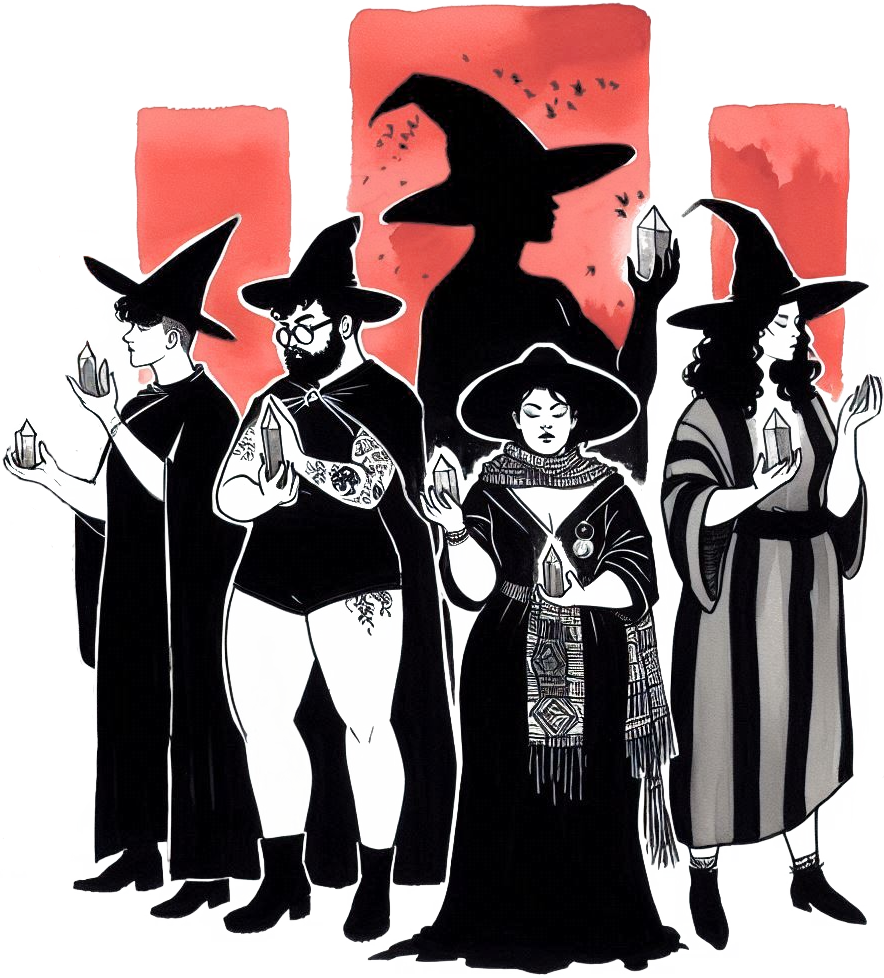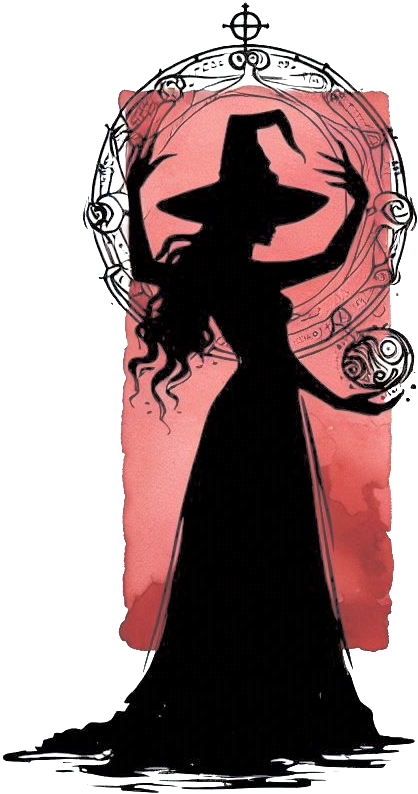
The topic of witchcraft is large and diverse. The solution most teachers find is to narrow the field and teach only a small portion of the entire craft. Usually they will allude to 'other traditions' and 'other ways' but those are not part of what they are teaching. That works well for a lot of people at some point in their journey, but nothing is for everyone at every time in their lives. Instead of closing doors to redirect your focus, this space aims to open doors and let you wander.
With such a broad topic, any starting point is arbitrary. With that in mind, the way I have chosen to structure this is based on another arbitrary creation: the modern rainbow coloured seven chakra system. This thought system, or meme, if we are being honest, has been refined in its current form for a couple of centuries. It is no surprise that it is appealing to the western human mind, including mine and maybe yours. This is just one organisational framework among many. Feel free to take what works and leave the rest. Rearrange as you will.
Recognising that there is no beginning, no one single font of wisdom or authenticity, we start at the root chakra. Coloured red for the primal blood of birth, violence, and life. Immediate. Visceral. The experience of the body rooted in the material plane. In the philosophy of Yoga, energy is created deep in the bowels and reproductive organs. The parts of the body closest to the earth when seated for meditation.
Put a pin in that thought. We will get back to it later.
What does it mean to start at the root? If we are starting with the red thread, with the base, we have to start with the basics. The body. The land. The ancestors. The practices that are so old, so woven into our lives, that we do not always even see them as magic. But they are. The way we feed people. The way we heal people. The way we protect children and mourn our dead. All the things that you do by instinct. All the things your people taught you to do without even meaning to. That is the red.
Witchcraft that starts at the root starts in the body. It starts in survival. It starts in the experience of being alive. That might mean embodiment or gender, but it might also mean pain, disability, hunger, addiction, recovery, estrangement, migration. The red root does not ask for you to be anything other than alive. It only asks that you show up. Because the work starts here.
✦ materia ✦
Let's be real. The first thing we think about when we think about witchcraft is things. Crystals, candles, brooms, swirling robes, rare herbs, cauldrons, cards, and corked glass vials. Ok, the last one might just be me. This is where conventional wisdom says I should tell you that none of that stuff matters, but I am not going to. In my experience that stuff matters, a lot. Up to a point. What matters more than tables of correspondences for various spell components is knowing which you really need, which you can substitute, and which you can forget.
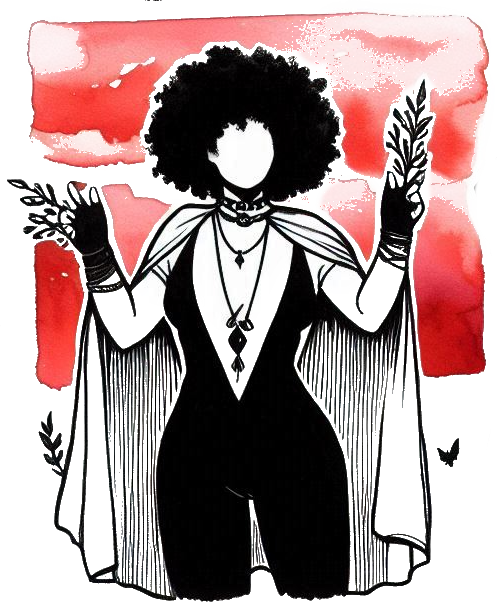
Here is the thing: witchcraft does not require expensive materials or hard-to-find ingredients. Some of the most powerful magic happens with what you already have. Salt from your kitchen, water from your tap, a leftover birthday candle from the junk drawer. The correspondences matter less than your intention and understanding. Where do those correspondence charts filling so many witchcraft books and websites come from? Which correspondences are the right ones? For the long term, those questions are more important to your practice than anything about what planets or moon phases go with which components.
While we are on the subject of the material plane, let us consider elemental systems, which end up being about as culturally complex as the history of chakras. Most modern witchcraft books will give some version of the 'Guardians and watchtowers of the North' system, which draws from the four-element theory originally described by Empedocles and later developed by Aristotle. This Western ceremonial magic system evolved over centuries, but the reasoning for associating the elements with specific directions does not hold up outside of Europe.
Different cultures have developed rich elemental traditions that deserve respect and understanding. In the Bakongo cosmology of Angola, a sophisticated system of elements includes different directional associations than those found in European traditions. What Europeans associated with fire and air are reversed in Bakongo understanding. The Bambara people of Mali work with similar elemental concepts but without rigid directional correspondences, focusing instead on the qualities and interactions of the elements themselves.
The Vedic traditions of India describe a profound five-element system (panchamahabhuta) where what we might call "air" is more specifically understood as vayu, wind that encompasses breath, life force, and movement. Tibetan Buddhist philosophy recognises five elements as well, with space (often called void) representing the fundamental openness in which all phenomena arise. Other Buddhist lineages work with four elements that, while sharing some commonalities with the Greek system, developed independently with their own cultural meanings.

Japanese Godai philosophy, influenced by both Vedic and Buddhist thought, offers another perspective on elemental understanding. Among the First Nations peoples of North America, there are diverse traditions involving four directions and elements, each with deep cultural significance that extends far beyond simple correspondences. Chinese Taoist philosophy presents the wuxing, five phases of water, wood, fire, earth, and metal, which describe not just elements but dynamic processes of change and relationship. What is fascinating about wuxing is that all five phases have complex interrelations that can be generative or destructive, creating a living system of understanding.
Hindu philosophy also includes the trigunas: three fundamental qualities (sattva, rajas, tamas) that exist in all manifest things. These are not elements in the Western sense but rather meta-qualities that pervade everything in the physical world, including the five elements themselves.
The point is not to become an expert in every system, but to recognise that elemental understanding is rich, diverse, and culturally rooted. When we borrow from these traditions, we should do so with respect and acknowledgment rather than assumption.
✦ mudra ✦
The word mudra comes from Sanskrit and is usually translated in English as 'gesture'. Now, we all know how important gestures are in witchcraft. There are gestures for cursing, defence, invoking, evoking, dispelling, blessing, and of course spell-casting. Gestures are even more fundamental than wands. "Isn't that just movie stuff?" I can hear you asking through time and space and the screen and stuff. It is movie stuff. But it is basically a chicken and egg situation, is it not? Are the gestures used in media a dramatization of real life magical gestures? Does the consistent portrayal of spell-casting gestures in media make us believe that gestures make our magic more powerful in real life? At this point in history, is there even any way to tell? In the practice of witchcraft, does it matter what empowers gestures, or does it simply matter that they are another tool in our arsenal when it comes to our craft? So why does it seem that gestures are mostly absent from modern books on witchcraft?
The word 'gesture' in its western sense is hardly an appropriate translation for the breadth and depth that the word mudra encompasses. There are mudras that direct the gaze, mudras for the feet and legs, and mudras for the entire body. Any intentional posture is considered mudra, which includes something you probably have encountered: asana, the yoga pose. In the tradition where these practices originated, the practice of asana in hatha yoga is considered fundamental preparation for all other spiritual activities.
Whether or not yoga asana are your thing, it is true that the preparation for witchcraft begins inside the witch, and some of that is absolutely physical. Taking care of your body's needs, managing your medical conditions, showing some care for your immediate environment. 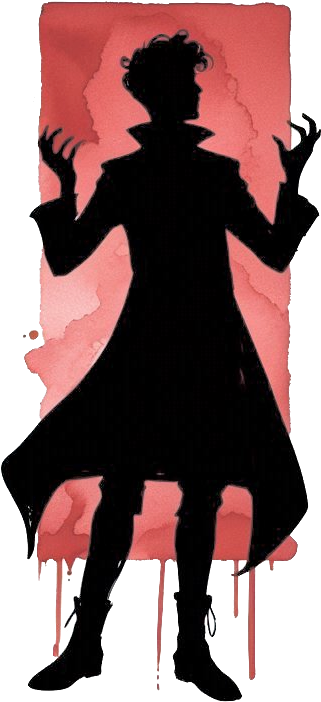 These are step one of spellwork. This does not require perfect health, a perfect body, or perfect circumstances. It requires working with what you have. Whether it is Tantra, Wicca, or sixteenth-century Welsh 'physicians', care for the body and basic cleanliness are called for before the practice of witchcraft. However, it does not call for a perfect physique, flawless health, or a luxurious magic sanctum. The requirement is subjective to your circumstances and goals, and part of practising witchcraft is developing the awareness to know when the requirements of your spell have been satisfied.
These are step one of spellwork. This does not require perfect health, a perfect body, or perfect circumstances. It requires working with what you have. Whether it is Tantra, Wicca, or sixteenth-century Welsh 'physicians', care for the body and basic cleanliness are called for before the practice of witchcraft. However, it does not call for a perfect physique, flawless health, or a luxurious magic sanctum. The requirement is subjective to your circumstances and goals, and part of practising witchcraft is developing the awareness to know when the requirements of your spell have been satisfied.
Ok, so back to that thing about the parts of your body closest to the ground. If you have not already, it will not be long until you hear about the practice of grounding. It is a common lesson for people new to witchcraft, and a lesson that would be useful for everyone to learn. This practice has roots in Hindu and Yogic philosophies that recommend meditation postures based on maximum contact with the earth. This is why Padmasana (lotus pose) is preferred to simple crossed legs, as it puts your knees and butt in contact with the ground, rather than just your backside. This is also why many yoga practices begin and end in Shavasana (corpse pose), as this pose offers maximum contact with the earth.
You are going to notice references to Hinduism and Patanjali's Raja Yoga as we move along. That is because many of the 'core' 'New Age' beliefs in the modern English-speaking world have roots in Hindu scriptures and Yoga sutras. These ideas were often adopted and adapted by Western spiritual movements, sometimes without proper acknowledgment of their origins. This happened particularly during the colonial period, when Western practitioners praised aspects of Indian culture while that same culture was being systematically oppressed. If you are drawn to these practices, I encourage you to learn about their origins and engage with them respectfully, recognising their cultural context and significance.
✦ manner ✦
Notice that is manner, not manners. As in 'what is the manner of a witch?', 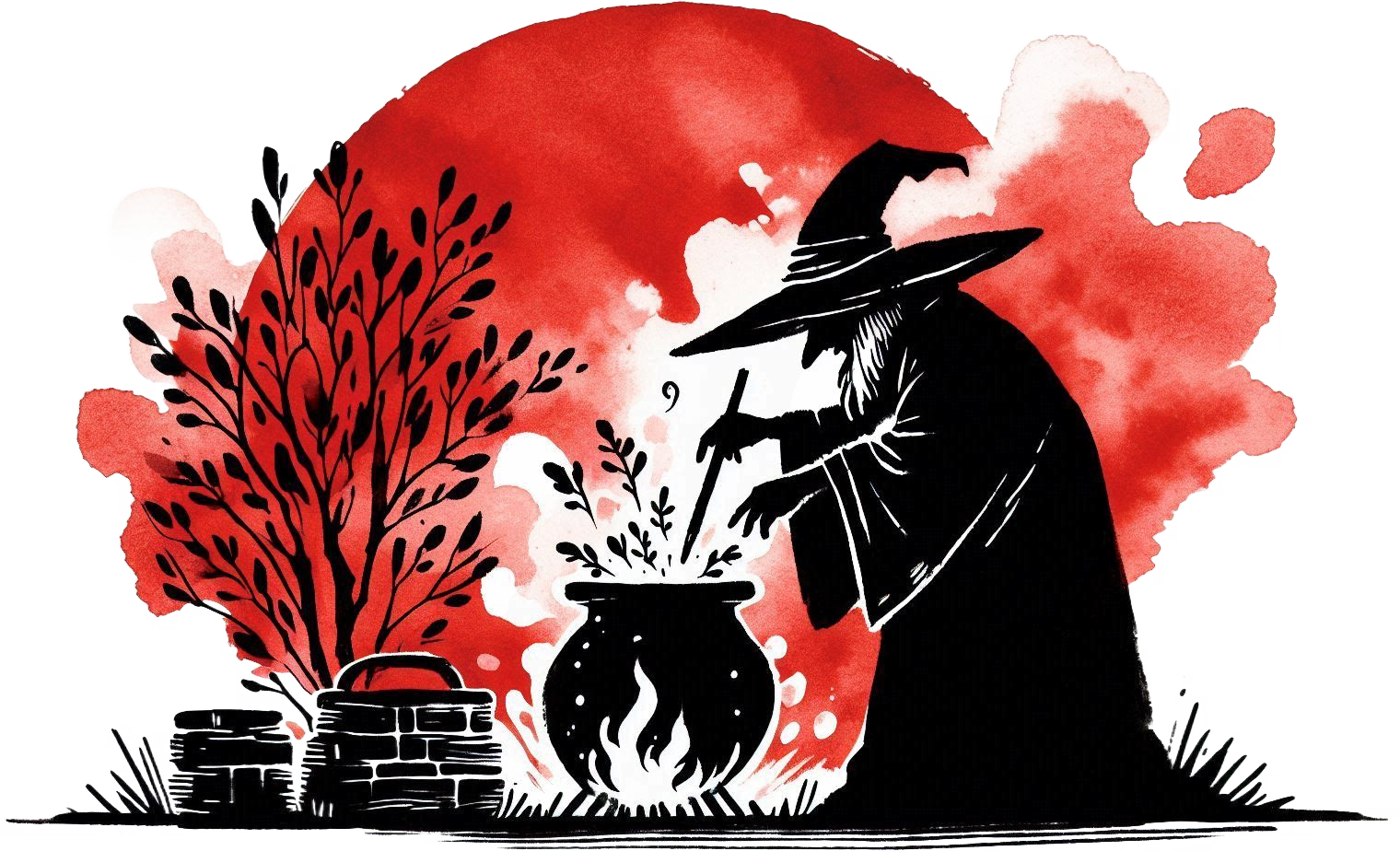 which means who is a witch, how does a witch act, and how does a witch appear. This is worthy of a lot more attention than it gets. Historically, according to legal precedent, these things were quite specifically defined, though in practice we can observe other specific characteristics of a witch in those times. A witch was someone denounced for witchcraft by someone in their community. A witch was not well liked by their neighbours. Witches were more likely to be property holders, particularly women of independent means. Conversely, female paupers were often found to be guilty of witchcraft. The legally cited definition became quite flexible in the face of the real factors that were at play in labelling someone a witch.
which means who is a witch, how does a witch act, and how does a witch appear. This is worthy of a lot more attention than it gets. Historically, according to legal precedent, these things were quite specifically defined, though in practice we can observe other specific characteristics of a witch in those times. A witch was someone denounced for witchcraft by someone in their community. A witch was not well liked by their neighbours. Witches were more likely to be property holders, particularly women of independent means. Conversely, female paupers were often found to be guilty of witchcraft. The legally cited definition became quite flexible in the face of the real factors that were at play in labelling someone a witch.
These 'witches' were not part of a secret goddess cult. They were not guardians of ancient feminine mysteries, as not even all of them were women. The majority of the people killed in witch trials historically were Christians, whether Catholic, Protestant, Byzantine Rite, Gnostic, non-secular, or some small splinter group. When they were not Christian, they were often Jews, reflecting the broader patterns of scapegoating and persecution that targeted marginalised communities throughout European history. Muslims, when present in European territories, faced similar persecution, though the religious and cultural conflicts of the time often prevented different persecuted groups from finding common ground.
Obviously this is when the cultural image of a witch we know today began to coalesce. A witch is a woman, probably an old one. A witch is opposed to goodness and society (also known as the church or religion du jour). It will probably surprise you to hear that one stereotype of a witch from this time period holds true. A witch is someone who takes more agency than what God has granted them, even at the ultimate cost. Ok, you have probably never heard it phrased like that. I bet you have encountered ideas like: A witch makes pacts with dark powers. A witch practises forbidden arts. A witch knows secrets others do not know. What is the issue with those things? They take power not normally allotted by the Christian God's plan. And thus, the primary sin of witchcraft in a Christian context is pride.

So let us talk about who a witch is. A witch can be any gender. A witch can be any sexuality. A witch can be any race. A witch can be any religious background or any current religion. A witch is defined first and foremost by their witchcraft, and secondarily by their knowledge. Not culture, prestigious friends, or a fancy lineage. Documented continuous lineages of witchcraft are extremely rare before the modern era, compared to the extensive documentation we have of secret cults of unorthodox Roman deities or early Christianity. Claims of ancient unbroken lineages should be approached with healthy scepticism without further evidence.
We live in a time when knowledge is more freely available than at any other time in history, in many ways. The biggest barrier to acquiring it is gatekeeping behind layers and layers of various agendas, many of which are currently and have been historically, commercial. That makes it more possible than ever for people to become witches on their own, using books, online resources, and personal experimentation. A lot of people see this as a negative thing, but I personally think it is great. Economic barriers should not determine who gets to practise witchcraft. If you are a practising witch who knows what you are doing, it does not matter where you learned from or how much money you spent learning it.
Witchcraft is and has always been a subversive practice. That is why it is attributed to outsiders living on the fringes of society. It offers unseen powers to the powerless. How could it not be subversive? If there is one commonality between witches other than their practice and knowledge, it is that all of us have experienced powerlessness. Witchcraft is a powerful remedy where there is no other.
